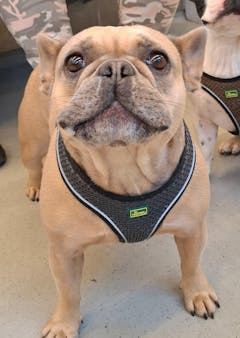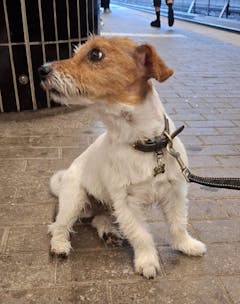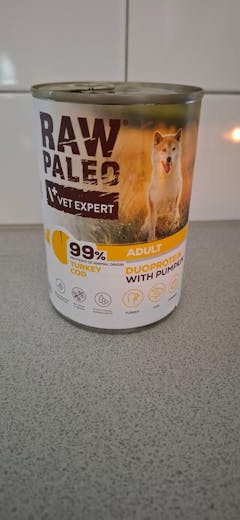Våtfoder för hundar
Våtfoder för Hundar: Ökad Smaklighet, Vätska och Välbefinnande
För många hundar är våtfoder för hundar inte bara en måltid – det är en fest! Med sin rika doft, saftiga textur och höga smaklighet är våtfoder ett utmärkt sätt att berika din hunds kost och säkerställa att den får i sig tillräckligt med vätska. På Zoostar.se hittar du ett brett och noggrant utvalt sortiment av våtfoder för hundar, anpassat för hundar i alla åldrar, storlekar och med olika näringsbehov. Oavsett om din hund är kräsen, behöver extra vätska, eller helt enkelt älskar en smakrik variation, har vi det perfekta våtfodret som kan komplettera eller utgöra basen i dess diet. Låt oss dyka djupare in i fördelarna med våtfoder och hur du väljer det bästa för din fyrbenta vän.
Fördelar med Våtfoder för Hundar
Våtfoder, ofta kallat blötmat, erbjuder flera unika fördelar som gör det till ett värdefullt tillskott till eller en komplett bas för din hunds diet:
- **Ökat Vätskeintag:** Den mest framstående fördelen med våtfoder är dess höga vattenhalt, som vanligtvis ligger mellan 70-85%. Detta bidrar avsevärt till hundens dagliga vätskebehov, vilket är särskilt fördelaktigt för hundar som dricker dåligt, eller de med njur- och urinvägsproblem där ett högt vätskeintag kan hjälpa till att spola igenom systemet och späda ut urinen.
- **Hög Smaklighet och Aptitretande:** Våtfoder är generellt sett mycket mer smakligt och aromatiskt än torrfoder. Den rika doften och den mjuka, saftiga konsistensen lockar ofta även de mest kräsna ätare. Detta gör det till ett utmärkt val för hundar med nedsatt aptit på grund av ålder, sjukdom, stress eller medicinering.
- **Lättsmält och Skonsamt:** Den mjuka konsistensen gör våtfoder lättare att tugga och svälja, vilket är idealiskt för valpar, äldre hundar med tandproblem eller hundar som återhämtar sig från sjukdom. Dessutom kan det vara skonsammare för magen och bidra till en bättre matsmältning för vissa hundar.
- **Viktkontroll:** Trots att våtfoder ser ut att vara en större portion per kalori, är det faktiskt ofta lägre i kaloriinnehåll per volym jämfört med torrfoder på grund av den höga vattenhalten. Detta kan vara fördelaktigt för hundar som behöver gå ner i vikt, eftersom de kan äta en större volym mat och känna sig mättare på färre kalorier.
- **Variation och Berikning:** Att växla mellan torrfoder och våtfoder, eller att blanda dem, kan bidra till att berika hundens kost och hålla måltiderna intressanta. Vissa hundar mår bra av att få olika proteinkällor och texturer.
Typer av Våtfoder och Hur Du Väljer Rätt
Precis som med torrfoder finns våtfoder i många varianter, anpassade för olika behov:
1. Komplett Helfoder vs. Kompletteringsfoder:
Det är avgörande att förstå skillnaden mellan ett komplett våtfoder (helfoder) och ett kompletteringsfoder.
- **Komplett Helfoder:** Dessa våtfoder är näringsmässigt balanserade och kan utgöra hundens enda kost. De innehåller alla nödvändiga proteiner, fetter, kolhydrater, vitaminer och mineraler som din hund behöver för att må bra i sitt specifika livsstadium. Leta efter märkningen "komplett hundfoder" eller "helfoder" på förpackningen.
- **Kompletteringsfoder:** Dessa är inte näringsmässigt kompletta och är avsedda att blandas med ett komplett torrfoder eller som ett smakfullt tillskott. De saknar den fullständiga näringsbalansen för att vara en hel diet. Att bara ge kompletteringsfoder kan leda till näringsbrister över tid.
2. Anpassning efter Ålder och Storlek:
- Våtfoder för Valpar: Valpvåtfoder är speciellt formulerat för att stödja den snabba tillväxten med högre protein- och fettinnehåll. Dess mjuka konsistens är idealisk för valpar som håller på att vänja sig vid fast föda. Även mjölkersättning och valpvälling finns för de allra minsta.
- Våtfoder för Seniorhundar: Äldre hundar kan dra nytta av våtfoder som är lättsmält och skonsamt för lederna. Den höga vattenhalten är bra för äldre hundar som kan ha nedsatt törstkänsla.
- Anpassning för rasstorlek: Vissa märken erbjuder våtfoder med olika näringsprofiler anpassade för små, medelstora eller stora raser.
3. Särskilda Behov och Hälsotillstånd:
- Allergier och Känslig Mage: För hundar med foderallergier eller känslig mage finns våtfoder med begränsat antal ingredienser (Limited Ingredient Diets, L.I.D.) eller hydrolyserat protein. Spannmålsfritt våtfoder är också ett populärt val för känsliga magar.
- Veterinärfoder: För specifika medicinska tillstånd som njursjukdom, diabetes, urinvägsproblem eller svåra allergier, finns särskilda veterinärfoder i våtfoderform. Dessa ska enbart användas på rekommendation av en veterinär.
- Viktkontroll: Våtfoder med lägre energitäthet kan hjälpa hundar att känna sig mätta under viktminskning.
Kvalitet och Ingredienser i Våtfoder
När du väljer våtfoder, precis som med all hundmat, är det viktigt att granska ingredienslistan. Ett högkvalitativt våtfoder bör ha:
- **Namngiven Proteinkälla:** Som första ingrediens bör det finnas en specifik kött- eller fiskkälla (t.ex. kyckling, lamm, lax, nötkött). Detta säkerställer att du vet vad din hund äter.
- **Hög Kvalitet på Råvarorna:** Foder tillverkat med färska, högkvalitativa ingredienser är alltid att föredra.
- **Begränsat med Fyllnadsmedel:** Undvik foder med onödiga fyllnadsmedel, konstgjorda färger, smaker och konserveringsmedel.
- **Balanserad Näringsprofil:** Även om våtfoder har hög vattenhalt, ska det ändå vara balanserat med nödvändiga vitaminer, mineraler och spårämnen om det är ett komplett helfoder.
Kombinera Våtfoder med Torrfoder och Andra Tillskott
Många hundägare väljer att kombinera våtfoder med torrfoder. Detta "hybridutfodrings"-koncept gör det möjligt att dra nytta av fördelarna med båda foderformerna:
- Våtfodrets aptitlighet och vätskeintag.
- Torrfodrets ekonomiska fördelar och dess bidrag till mekanisk tandrengöring.
Kom ihåg att även inkludera hundgodis och tuggbitar i den totala kaloriberäkningen för att undvika övervikt.
Korrekt Förvaring av Våtfoder
Oöppnade burkar och portionspåsar med våtfoder bör förvaras på en sval och torr plats, borta från direkt solljus. När en förpackning väl har öppnats, måste eventuella rester förvaras i kylskåp i en lufttät behållare och konsumeras inom 3-5 dagar. Lämna aldrig öppnat våtfoder framme i rumstemperatur under längre perioder.
Zoostar.se – Din Partner för Smakrikt Våtfoder
På Zoostar.se är vi dedikerade till att erbjuda din hund den bästa möjliga näringen. Vårt sortiment av våtfoder för hundar är noga utvalt för att säkerställa högsta kvalitet, smaklighet och näringsvärde. Oavsett om du letar efter ett komplett helfoder, ett smakfullt tillskott till torrfodret, eller specialanpassat våtfoder för en hund med särskilda behov, hittar du det hos oss. Utforska hela vårt utbud av hundmat och foder och ge din hund en välförtjänt och hälsosam måltid. Hos oss hittar du det våtfoder som din hund kommer att älska!
Vanliga frågor om Våtfoder för Hundar
Här besvarar vi några av de mest frekventa frågorna vi får angående våtfoder för hundar.
När är våtfoder ett bra val för min hund?
Våtfoder, även känt som blötmat, är ett utmärkt komplement till eller alternativ till torrfoder för många hundar. Dess höga vattenhalt och aptitlighet gör det till ett fördelaktigt val i flera situationer. Här är när våtfoder kan vara ett särskilt bra alternativ för din hund: 1. För att Öka Vätskeintaget: Detta är kanske den mest framstående fördelen med våtfoder. Med en vattenhalt på 70-85% bidrar våtfoder betydligt till hundens dagliga vätskeintag. Detta är särskilt viktigt för: - Hundar som inte dricker tillräckligt med vatten. - Hundar med njur- eller urinvägsproblem (t.ex. urinsten), där ett högt vätskeintag kan hjälpa till att spola igenom urinsystemet och späda ut urinen. - Hundar som lever i varma klimat eller under fysiskt ansträngande förhållanden. 2. För Kräsna Hundar och att Stimulera Aptiten: Våtfoder är generellt sett mycket mer smakligt och aromatiskt än torrfoder. Den rika doften och den mjuka konsistensen lockar ofta även de mest kräsna ätare. Detta gör det till ett utmärkt val för: - Hundar med nedsatt aptit på grund av ålder, sjukdom, stress eller medicinering. - Hundar som bara inte verkar gilla sitt torrfoder. - För att göra måltiderna mer attraktiva och varierande. 3. För Hundar med Tandproblem eller Svårigheter att Tugga: Den mjuka konsistensen hos våtfoder gör det lättare att tugga och svälja för hundar som: - Har tandproblem (t.ex. saknade tänder, smärtsamma tänder eller tandköttsinflammation). - Är äldre och har svagare tänder. - Har någon form av mun- eller käkskada. 4. För Viktkontroll (Viktminskning): Trots att våtfoder ser ut att vara en större portion per kalori, är det faktiskt ofta lägre i kaloriinnehåll per volym jämfört med torrfoder på grund av den höga vattenhalten. Detta kan vara fördelaktigt för hundar som behöver gå ner i vikt, eftersom de kan äta en större volym mat och känna sig mättare på färre kalorier. 5. För att Erbjuda Variation i Kosten: Att växla mellan torrfoder och våtfoder, eller att blanda dem, kan bidra till att berika hundens kost och hålla måltiderna intressanta. Vissa hundar drar nytta av att få olika proteinkällor och texturer. 6. För Små Valpar som Börjar Äta Fast Föda: Valpar som håller på att vänja sig vid fast föda kan ha lättare att äta våtfoder eller en blandning av våtfoder och uppblött torrfoder. 7. Efter Operation eller Sjukdom: Våtfoder kan vara lättare för en hund att smälta och äta under återhämtning från sjukdom eller operation, då aptiten kan vara nedsatt och magen känslig. 8. Vissa Medicinska Tillstånd: För specifika tillstånd som t.ex. förstoppning (hög vattenhalt kan hjälpa), eller när en specifik diet krävs som är lättare att administrera i våtfoderform (exempelvis vissa veterinärfoder). Att välja våtfoder kan vara ett utmärkt sätt att komplettera din hunds kost eller erbjuda en fullvärdig måltid som uppskattas extra mycket. Många väljer att blanda våtfoder med torrfoder för att kombinera fördelarna från båda typerna.
Kan våtfoder utgöra en hunds fullständiga diet?
Ja, våtfoder kan absolut utgöra en hunds fullständiga och balanserade diet, förutsatt att det är ett så kallat "helfoder" eller "komplett foder". Det är viktigt att förstå skillnaden mellan ett komplett våtfoder och ett kompletteringsfoder. Komplett våtfoder (helfoder): Dessa är formulerade för att ensamt tillgodose alla hundens näringsbehov. Precis som torrfoder är ett komplett våtfoder noga balanserat med rätt proportioner av proteiner, fetter, kolhydrater, vitaminer och mineraler som en hund behöver för att må bra under sitt specifika livsstadium (valp, vuxen, senior) och eventuella särskilda behov. Om förpackningen tydligt anger att det är ett "komplett foder" eller "helfoder", kan det ges som hundens enda matkälla utan att behöva kompletteras med andra näringsämnen. Kompletteringsfoder: Dessa är inte näringsmässigt kompletta på egen hand. De är ofta utformade för att vara ett tillskott till hundens primära kost (oftast torrfoder) för att öka smakligheten, bidra med extra vätska eller som en belöning. Kompletteringsfoder saknar den fullständiga näringsbalansen som krävs för en hel diet. Att enbart utfodra med ett kompletteringsfoder kan leda till näringsbrister över tid. Hur vet man om våtfodret är komplett? Läs alltid etiketten på förpackningen noga. Leta efter termer som "komplett hundfoder", "helfoder", "näringsmässigt komplett" eller liknande formuleringar. Tillverkarna är skyldiga att deklarera om produkten är ett helfoder eller ett kompletteringsfoder. Fördelar med en diet baserad enbart på komplett våtfoder: - Högt vätskeintag: Bidrar utmärkt till hundens dagliga vätskebehov, vilket är fördelaktigt för njurar och urinvägar. - Mycket aptitligt: Utmärkt för kräsna hundar eller de med nedsatt aptit. - Lättsmält: Kan vara skonsammare för magen hos vissa hundar. - Lätt att äta: Perfekt för hundar med tandproblem eller äldre hundar. Nackdelar med en diet baserad enbart på komplett våtfoder: - Kostnad: Generellt dyrare per portion jämfört med torrfoder. - Tandhälsa: Bidrar inte till tandrengöring på samma sätt som torrfoder, vilket kan kräva mer aktiv tandvård. - Förvaring: Öppnade förpackningar måste förvaras i kylskåp och konsumeras snabbt. - Miljöaspekt: Genererar mer förpackningsavfall. Sammanfattningsvis: Om du väljer ett våtfoder som är märkt som ett "komplett foder" för hundens specifika livsstadium, kan det absolut utgöra hundens enda kost. Många väljer dock att kombinera våtfoder med torrfoder för att dra nytta av fördelarna med båda foderformerna – våtfodrets aptitlighet och vätskeintag, samt torrfodrets ekonomiska fördelar och bidrag till tandhälsa.
Hur förvarar jag våtfoder korrekt efter öppning?
Korrekt förvaring av våtfoder efter att förpackningen har öppnats är avgörande för att bibehålla dess fräschör, näringsvärde och för att förhindra bakterietillväxt som kan göra din hund sjuk. På grund av den höga vattenhalten är våtfoder mer känsligt för nedbrytning än torrfoder. Här är de viktigaste stegen för att förvara våtfoder korrekt: 1. Förvara i Kylskåp: Så snart en burk eller påse med våtfoder har öppnats måste eventuella rester omedelbart förvaras i kylskåp (vid en temperatur mellan 4°C och 7°C). Kylan saktar ner tillväxten av bakterier som kan förstöra fodret och göra det osäkert för din hund att äta. 2. Använd en Lufttät Behållare eller Täck Över: Det bästa är att överföra våtfodret till en lufttät behållare av livsmedelskvalitet (glas eller plast) med ett tättslutande lock. Detta förhindrar att fodret torkar ut, tar upp lukt från andra livsmedel i kylskåpet, och skyddar det från kontaminering. Om du inte har en lämplig behållare, täck över originalburken noggrant med plastfolie, aluminiumfolie eller ett speciellt burklock som är utformat för djurmat. 3. Hållbarhet i Kylskåp: Öppnat våtfoder bör konsumeras inom 3-5 dagar efter att det öppnats. Även om det ser och luktar okej, kan bakterier ha börjat växa i mängder som inte är säkra att äta. Ju kortare tid det står, desto bättre. Om din hund inte äter upp allt våtfoder inom denna tidsram, bör du kasta resterna. 4. Undvik direkt exponering för luft: Även i kylskåp kan luft torka ut fodret och påverka smaken. Därför är en lufttät förvaring så viktig. 5. Serveringstemperatur: De flesta hundar föredrar att äta våtfoder som inte är kylskåpskallt. Om du har förvarat fodret i kylskåpet, kan du låta det stå i rumstemperatur i cirka 15-30 minuter före servering, eller värma det försiktigt i mikrovågsugnen (se till att det inte blir för varmt och rör om ordentligt för att undvika hot spots). Kasta bort oanvänd mat från skålen efter 30-60 minuter, särskilt i varmare klimat, för att förhindra bakterietillväxt. Vad man ska UNDVIKA: - Lämna inte öppnat våtfoder framme i rumstemperatur längre än absolut nödvändigt (max 2-4 timmar, beroende på rumstemperaturen). Bakterier förökar sig snabbt vid rumstemperatur. - Frysning: Även om våtfoder kan frysas, rekommenderas det sällan för att bibehålla optimal kvalitet och konsistens, då det kan ändra fodrets textur och smakligheten vid upptining. Det är generellt sett bättre att köpa mindre förpackningar som din hund kan äta upp inom den rekommenderade tiden. Genom att följa dessa enkla riktlinjer för förvaring kan du se till att din hunds våtfoder alltid är fräscht, säkert och behåller sitt näringsvärde, vilket bidrar till dess hälsa och aptit.
Husdjursprodukter Online
Utforska fler populära hundkategorier
Här hittar du många av våra mest efterfrågade kategorier – från hundfoder och godis till tillbehör, vård och aktivering.
Ledande Fodertillverkare
Populära hundfodermärken
Här hittar du våra mest populära hundfoder – från spannmålsfritt till veterinärfoder. Klicka på ett varumärke för att se hela sortimentet.






